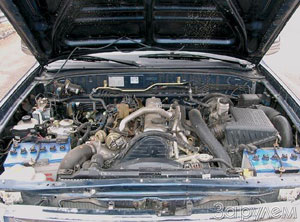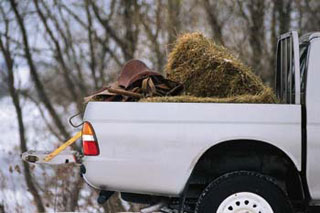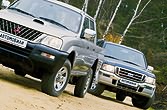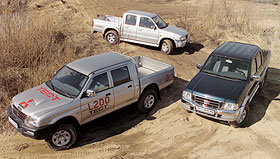Test drive Mitsubishi L200 Single Cab 1995 - 2005 pickup
Thai tonnage
 Ford Ranger
Ford Ranger The current, the second generation of pickups has been produced at the enterprise Auto -Ealiance in Thailand since 1998 and exported, including to Europe; In 2003, the appearance (facelifting) was updated.
The start of deliveries to Russia is the summer of 2004: an all-wheel drive modification with a 2.5-liter diesel and a mechanical box. There are also versions with short and elongated cabs, a V6 gasoline engine and an automatic machine, rear -wheel drive.
At the same factory, the Mazda-B2500 pickup is produced, characterized only by elements of body design. The American namesake of the Ranger produced in Thailand is not his analogue.
The price in Russia from 19,270 euros ($ 23,000 at the time of preparation of the material).
Mitsubishi L200
L200 pickups are produced in Thailand, for local markets also in South Africa and Malaysia.
On the Russian market, a 4x4 version with a double cab and a 2.5-liter diesel engine is presented.
The full range of modifications opens
80-horsepower rear-wheel drive, and crown 4x4 with a V6 gasoline engine and an automatic box. There are versions with short and elongated cabins.
The model is known in Europe under the name L200, in Australia Titon, Southeast Asia Storm and L200 Street, South Africa Colt. The nearest constructive analogue
pikapa MITSUBISHI Pajero Sport.
The price in Russia from $ 21,650.
With the exception of appearance, they are very similar to purpose, size, design, and technical characteristics. Both are taken in a ton. They release them in the neighborhood, in factories in the distant Thailand. And the main features coincide: being analogues of ordinary all -terrain vehicles with full -fledged salons, pickups are 1.52 times cheaper, which makes them a very interesting offer in this market sector.
 Cowboy dispute and samurai
Cowboy dispute and samurai Burdened with thoughts about the similarity of two cars, we went to the training ground to find the differences and at least answer the question for ourselves: what to choose? One of the authors took the side of the rangers and, leaning in the pose of Chuck Norris on the wing of the faithful Ford, said:
They are met, as you know, by clothing. You won’t argue that my car is more solid both outside and inside? Look at what practical cap is adapted to the body, how the radiator shines with a chrome, how spacious the salon, especially behind, and agree that the first round is behind me!
The colleague sitting at the wheel of Mitsubisi squinted cunningly, why his round face began to remind the Japanese, and, turning to the rising sun, answered:
Why judge unfounded? Compare the dimensions of the salons: mine, if it is inferior, is completely not much. In the back, indeed, the sofa is rustic, but the upholstery is more practical. L200 looks much more dynamic and fit than brutal, thick Ford. As for the cap to the body, this is an option available for Mitsubishi. And not always convenient, which you will be convinced now: it is not worth comparing workhorses only by the length of the mane
 Dispute of business entities
Dispute of business entities Indeed, these machines should not only drive, but work, carry not only the owner, but also the load. In our test, 30-kilogram bags with sand. The loading height and size of the body differ very slightly, but the beautiful cap of Ford, although it reliably covers the luggage, interferes with working in the back. A couple of times cracked on the roof with maneuvers with bags in a tight body, the cowboy suspended loading: for ballast they took 660 kg on board, or 2/3 of the declared load capacity. Now let's see what has changed and a lot has changed: the ranger turned around the transverse axis passing approximately through the distribution box, which is why the front wheels are slightly unloaded (see table.). The distance from the Earth to the towbar decreased by 100 mm, and to the crossbreak of the front suspension increased by 20 mm.
About the same thing happened with L200, but to a lesser extent: the clearance to the opposite beam decreased by 85 mm, to the front suspension beam grew by 15 mm.
So, the American squats under load lower. He feels the load more on the go. Ford loaded with ballast was not shared 3.5 km/h maximum speed, and almost seven extra seconds were required to accelerate up to a hundred. Nevertheless, the ranger came out the winner (see table.).
 Driving dispute
Driving dispute Mitsubishi is clearly faster than this American Uvarp.
Where, tell me, will the speed take if the weight is the same, and the horses and Newtonians are less? Yes, and shakes in the Japanese, like on a chipper hammer.
For a vibration truck, it is acceptable, it is in Ford.
This dispute will stop only a measurement program on a dynamometric road, where you can hit science and numbers on opinions and doubts. A miracle, of course, did not happen. A more powerful ranger turned out to be faster, more dynamic, and more elastic said the exact device. But the sensations of sensations continued to deceive. The Japanese performs the driver’s commands faster, creating the impression of the car more frisky. L200 reacts more acutely to the rotation of the steering wheel. Its diesel responds sharply to the work of the gas pedal, the car is less rolling in corners. Ford will think, rummages with the engine, he will be pretty tilted, and then he will take it and still overtake Mitsubishi.
 The largest difference in suspension settings. A hard Japanese pickup passes every hole and potholes to the body, which the ranger impressively floats in the best American traditions. It would undoubtedly go along the tram tracks on the tram tracks, but it turns out to be problems on the off -road.
The largest difference in suspension settings. A hard Japanese pickup passes every hole and potholes to the body, which the ranger impressively floats in the best American traditions. It would undoubtedly go along the tram tracks on the tram tracks, but it turns out to be problems on the off -road. On a hunchback lane, Ford begins to actively sway from nose to feed and now the front suspension stroke limiters must be discouraged. The Japanese, although he jumps on the pits and potholes that your goat, is responsible for the principle of more than gas less than the pits.
And finally, a few words about cross -country ability. The potential capabilities of cars here are very close to the amazing similarity of design solutions. Both have a full -wheel drive, the rear self -locking differential, a painful diesel, a decent protection of the belly (Ford is more salty).
In a lobe at pickups: weak geometric indicators due to a long base and a large rear history and unloaded, on an empty car, the rear axle. Much, of course, depends on the toothness of the tires and the skills of the driver, but in general, off -road talents are as follows: you should not climb into the swamp or a wet arable land, but to overpower the drooping country, inaccessible to simple cars, pickups are quite possible.
Dispute of buyers
 No matter how arguing, the choice will be difficult cars are very close, and the differences are not so significant. When choosing, probably, it is worth focusing on financial indicators (the price of a car, additional equipment, maintenance, loan conditions) and personal preferences externally differ quite strongly.
No matter how arguing, the choice will be difficult cars are very close, and the differences are not so significant. When choosing, probably, it is worth focusing on financial indicators (the price of a car, additional equipment, maintenance, loan conditions) and personal preferences externally differ quite strongly. Well, which car is better?
What movie do you like more, Japanese seven samurai or an American magnificent seven?
SUMMARY
Ford Ranger is a very comfortable all -wheel drive passenger car adapted for cargo transportation.
+ Good dynamic indicators, comfort of the suspension on the asphalt, reliable protection of the units, attractive price.
- a noticeable deterioration in the characteristics of a loaded machine, a tendency to build up on broken roads, noticeable rolls in corners.
Mitsubishi L200 is a convenient, small, hard and fast all -wheel drive truck adapted to the transportation of people.
+ Impenetrable pendants, sharp and accurate control, practical interior decoration, attractive price.
- Low comfort for off -road, weak protection of the fuel tank, mediocre dynamics.




Igor Solidov, Anton Chuykin. Photo: Igor Solidov
A source: The magazine "Driving"



